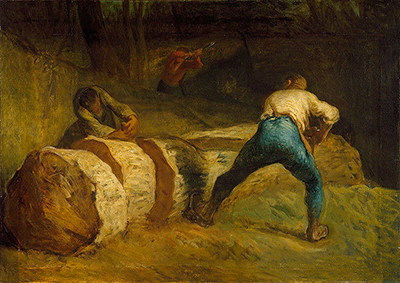The Wood Sawyers, 1850, is an artwork that depicts one of Miller’s peasant scenes, for which he was best known for. Two men are seen sawing a large trunk as another chops trees in the background. Millet renders a technical approach to light and colour. The setting of this painting suggests that his arrival in the Barbizon is post-dated despite the style appearing to be an early work.
Other paintings
Oedipus Taken Down from the Tree, 1847, is Millet’s one of the most celebrated creations. It is one of his few paintings that did not focus on rural French peasants. It depicts a mythological infant Oedipus character, who had been strung on a tree by his father. In this painting, the infant is seen being rescued by shepherds. This is an artwork inspired by the ancient Greek legend from his partisan period. Laius, the father of the infant, wanted his son to die, after believing the prediction that Oedipus would one day kill him.
The Sower, 1850, depicts a peasant with elaborate movement and a bag across his chest, trying to scatter seedlings into his farm. He is expressed as poor with apparent exhaustion of the work he is doing. His strides are wide, and with much effort, is seen sowing a new crop as crows circle behind him. The face of the peasant is depicted with coarse features, a deliberate elaboration of constant stress. In the background is a not so clear image of another peasant seen driving his team of oxen.
Harvesters Resting, 1853, was a chronicle of the plight of the farmers in France. The setting of this painting is conceived as the biblical story of Ruth, who was a poor widow. Ruth supported herself by gathering grain left of the harvest. Jean, however, twisted the title to reflect the contemporary stories of farmers of his time, where rich absentee landlords owned most of the Rural farms.
The Gleaners, 1875, is Jean’s most iconic artwork. It is an oil painting that depicts three peasant women seen to glean a field of stray stalks of wheat after the harvest. This artwork features a thoughtful way of presenting the lowest ranks of rural society. The French upper class, however, did not receive this well. The Gleaners was first revealed in 1857 and immediately drew negative criticism from the upper and middle classes. They viewed the painting as suspicious, one that glorified the lower-class workers. In this painting, the women’s faces and gazes are obscured, with the landowner standing in the background, keeping watch. Behind the women are bountiful amounts of wheat.




